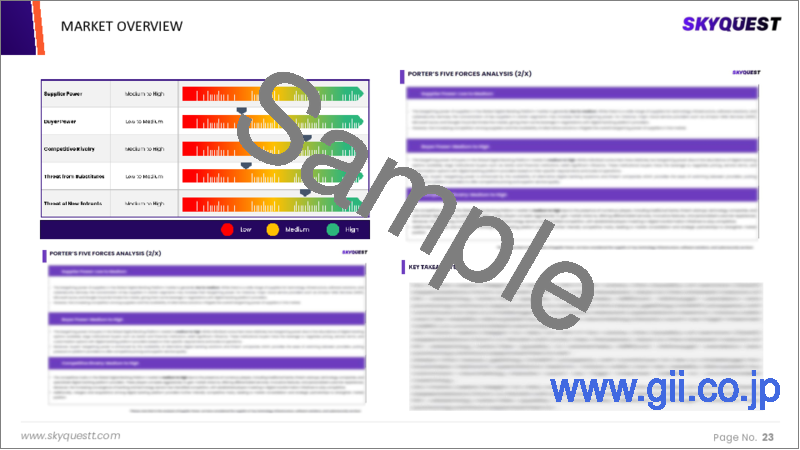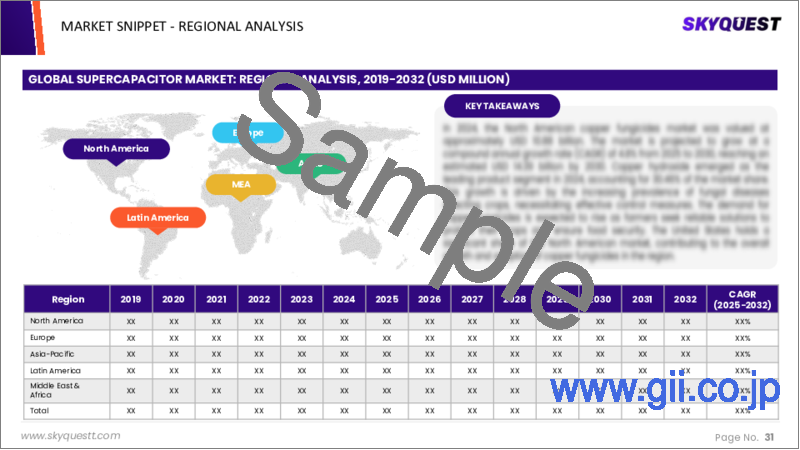|
|
市場調査レポート
商品コード
1673726
スーパーキャパシタの市場規模、シェア、成長分析:タイプ別、電極材料別、用途別、地域別 - 産業予測 2025~2032年Supercapacitor Market Size, Share, and Growth Analysis, By Type (Double-Layer Capacitor, Pseudocapacitor), By Electrode Material (Carbon, Metal Oxide), By Application, By Region - Industry Forecast 2025-2032 |
||||||
|
|||||||
| スーパーキャパシタの市場規模、シェア、成長分析:タイプ別、電極材料別、用途別、地域別 - 産業予測 2025~2032年 |
|
出版日: 2025年03月02日
発行: SkyQuest
ページ情報: 英文 202 Pages
納期: 3~5営業日
|
全表示
- 概要
- 目次
スーパーキャパシタ市場規模は2023年に38億米ドルとなり、予測期間(2025-2032年)のCAGRは24.6%で、2024年の47億3,000万米ドルから2032年には275億1,000万米ドルに成長する見通しです。
世界のスーパーキャパシタ市場は、主に持続可能でエネルギー効率の高いエネルギー貯蔵ソリューションに対する需要の高まりによって、大きな成長を遂げています。再生可能エネルギー源、特に太陽光発電や風力発電へのシフトは、断続的なエネルギー出力を調整するスーパーキャパシタの重要な役割を浮き彫りにしています。主な用途には、電気自動車(EV)、家電製品、エネルギー貯蔵システムなどがあり、スーパーキャパシタは電池寿命を延ばし、エネルギー効率を高め、回生ブレーキを促進します。市場の動向は、リチウムイオン電池とスーパーキャパシタを組み合わせたハイブリッドエネルギー貯蔵システムや、グラフェンや炭素系材料を利用した革新的な設計への関心が高まっていることを示しています。こうした進歩は、性能とエネルギー密度を向上させるだけでなく、持続可能性の目標にも合致するため、潜在的な応用範囲を広げ、市場拡大を後押しします。
目次
イントロダクション
- 調査の目的
- 調査範囲
- 定義
調査手法
- 情報調達
- 二次と一次データの方法
- 市場規模予測
- 市場の前提条件と制限
エグゼクティブサマリー
- 世界市場の見通し
- 供給と需要の動向分析
- セグメント別機会分析
市場力学と見通し
- 市場概要
- 市場規模
- 市場力学
- 促進要因と機会
- 抑制要因と課題
- ポーターの分析
主な市場の考察
- 重要成功要因
- 競合の程度
- 主な投資機会
- 市場エコシステム
- 市場の魅力指数(2024年)
- PESTEL分析
- マクロ経済指標
- バリューチェーン分析
- 価格分析
- ケーススタディ
- 技術分析
- 特許分析
スーパーキャパシタ市場規模:タイプ別& CAGR(2025-2032)
- 市場概要
- 二重層コンデンサ
- 擬似コンデンサ
- ハイブリッドコンデンサ
スーパーキャパシタ市場規模:電極材料別& CAGR(2025-2032)
- 市場概要
- 炭素
- 活性炭
- カーボンナノチューブ(CNT)
- グラフェン
- 炭化物由来炭素(CDC)
- カーボンエアロゲル
- 金属酸化物
- 酸化ルテニウム
- 酸化ニッケル
- 酸化マンガン
- 導電性ポリマー
- ポリアニリン(PANI)
- ポリピロール
- ポリアセン
- ポリアセチレン
- 複合材料
- 炭素炭素
- 炭素金属酸化物
- 炭素導電性ポリマー
スーパーキャパシタ市場規模:用途別& CAGR(2025-2032)
- 市場概要
- 自動車
- エネルギー
- 家電
- 産業
- 航空宇宙
- 医療
スーパーキャパシタ市場規模:地域別& CAGR(2025-2032)
- 北米
- 米国
- カナダ
- 欧州
- ドイツ
- スペイン
- フランス
- 英国
- イタリア
- その他欧州地域
- アジア太平洋地域
- 中国
- インド
- 日本
- 韓国
- その他アジア太平洋地域
- ラテンアメリカ
- ブラジル
- その他ラテンアメリカ地域
- 中東・アフリカ
- GCC諸国
- 南アフリカ
- その他中東・アフリカ
競合情報
- 上位5社の比較
- 主要企業の市場ポジショニング(2024年)
- 主な市場企業が採用した戦略
- 最近の市場動向
- 企業の市場シェア分析(2024年)
- 主要企業の企業プロファイル
- 企業の詳細
- 製品ポートフォリオ分析
- 企業のセグメント別シェア分析
- 収益の前年比比較(2022-2024)
主要企業プロファイル
- Panasonic Corporation(Japan)
- Nippon Chemi-Con Corporation(Japan)
- Skeleton Technologies(Estonia)
- Yunasko(Ukraine)
- AVX Corporation(USA)
- ELNA Co. Ltd.(Japan)
- CAP-XX Limited(Australia)
- Murata Manufacturing Co. Ltd.(Japan)
- Supreme Power Solutions Co. Ltd.(China)
- Tesla Inc.(USA)
- WIMA Group(Germany)
- XG Sciences(USA)
- Jianghai Capacitor Co. Ltd.(China)
- Paper Battery Company Inc.(USA)
- TDK Corporation(Japan)
- VINATech Co. Ltd.(South Korea)
結論と提言
Supercapacitor Market size was valued at USD 3.8 billion in 2023 and is poised to grow from USD 4.73 billion in 2024 to USD 27.51 billion by 2032, growing at a CAGR of 24.6% during the forecast period (2025-2032).
The global supercapacitor market is experiencing significant growth, primarily driven by the rising demand for sustainable and energy-efficient energy storage solutions. The shift towards renewable energy sources, particularly in solar and wind power, highlights the crucial role of supercapacitors in regulating intermittent energy output. Key applications include electric vehicles (EVs), consumer electronics, and energy storage systems, where supercapacitors enhance battery life, boost energy efficiency, and facilitate regenerative braking. Trends in the market indicate a growing interest in hybrid energy storage systems that combine lithium-ion batteries with supercapacitors, as well as innovative designs utilizing graphene and carbon-based materials. These advancements not only improve performance and energy density but also align with sustainability goals, broadening the scope of potential applications and propelling market expansion.
Top-down and bottom-up approaches were used to estimate and validate the size of the Supercapacitor market and to estimate the size of various other dependent submarkets. The research methodology used to estimate the market size includes the following details: The key players in the market were identified through secondary research, and their market shares in the respective regions were determined through primary and secondary research. This entire procedure includes the study of the annual and financial reports of the top market players and extensive interviews for key insights from industry leaders such as CEOs, VPs, directors, and marketing executives. All percentage shares split, and breakdowns were determined using secondary sources and verified through Primary sources. All possible parameters that affect the markets covered in this research study have been accounted for, viewed in extensive detail, verified through primary research, and analyzed to get the final quantitative and qualitative data.
Supercapacitor Market Segments Analysis
Global Supercapacitor Market is segmented by Type, Electrode Material, Application and region. Based on Type, the market is segmented into Double-Layer Capacitor, Pseudocapacitor and Hybrid Capacitor. Based on Electrode Material, the market is segmented into Carbon, Metal Oxide, Conducting Polymers andcomposites. Based on Application, the market is segmented into Automotive, Energy, Consumer Electronics, Industrial, Aerospace and Medical. Based on region, the market is segmented into North America, Europe, Asia Pacific, Latin America and Middle East & Africa.
Driver of the Supercapacitor Market
One of the primary factors propelling the global supercapacitor market is the rising demand for electric vehicles (EVs). Supercapacitors play a crucial role in EVs, particularly in regenerative braking systems, where they enhance energy efficiency by capturing and reusing energy. This capability provides quick bursts of power, essential for optimal performance. As the electric vehicle sector continues to expand, there is an increasing necessity for supercapacitors and other advanced energy storage solutions. This surge in demand fuels innovation within the industry, fostering greater adoption and development of supercapacitor technologies to meet the evolving needs of the market.
Restraints in the Supercapacitor Market
The supercapacitor market faces significant challenges regarding manufacturing costs, particularly when it comes to producing high energy density and high voltage devices. The use of advanced materials such as graphene and carbon-based electrodes presents practical obstacles due to their expense, making large-scale production economically unfeasible for many companies. As a result, organizations that prioritize cost-effectiveness may struggle to adopt these innovative materials, which can hinder their ability to compete in the evolving marketplace. Consequently, the high production costs linked to specialized materials can act as a substantial restraint on the growth and advancement of the supercapacitor sector.
Market Trends of the Supercapacitor Market
The supercapacitor market is witnessing a notable trend towards the adoption of hybrid capacitors, driven by the increasing demand for efficient energy storage solutions in sectors like electric vehicles and industrial machinery. These hybrid systems leverage the advantageous characteristics of both traditional batteries and supercapacitors, offering enhanced energy density along with rapid charge and discharge capabilities. As industries seek to optimize performance and lifespan in energy-intensive applications, hybrid capacitors are becoming essential for improving the efficiency of electric cars and renewable energy systems. This trend underscores a broader shift towards advanced, high-performance energy storage technologies, positioning hybrid capacitors as a key driver in the supercapacitor market landscape.
Table of Contents
Introduction
- Objectives of the Study
- Scope of the Report
- Definitions
Research Methodology
- Information Procurement
- Secondary & Primary Data Methods
- Market Size Estimation
- Market Assumptions & Limitations
Executive Summary
- Global Market Outlook
- Supply & Demand Trend Analysis
- Segmental Opportunity Analysis
Market Dynamics & Outlook
- Market Overview
- Market Size
- Market Dynamics
- Drivers & Opportunities
- Restraints & Challenges
- Porters Analysis
- Competitive rivalry
- Threat of substitute
- Bargaining power of buyers
- Threat of new entrants
- Bargaining power of suppliers
Key Market Insights
- Key Success Factors
- Degree of Competition
- Top Investment Pockets
- Market Ecosystem
- Market Attractiveness Index, 2024
- PESTEL Analysis
- Macro-Economic Indicators
- Value Chain Analysis
- Pricing Analysis
- Case Studies
- Technology Analysis
- Patent Analysis
Global Supercapacitor Market Size by Type & CAGR (2025-2032)
- Market Overview
- Double-Layer Capacitor
- Pseudocapacitor
- Hybrid Capacitor
Global Supercapacitor Market Size by Electrode Material & CAGR (2025-2032)
- Market Overview
- Carbon
- Activated carbon
- Carbon nanotubes (CNT)
- Graphene
- Carbide-derived carbon (CDC)
- Carbon aerogels
- Metal Oxide
- Ruthenium oxide
- Nickel oxide
- Manganese oxide
- Conducting Polymers
- Polyaniline (PANI)
- Polypyrrole
- Polyacene
- Polyacetylene
- Composites
- Carbon-carbon
- Carbon-metal oxide
- Carbon-conducting polymers
Global Supercapacitor Market Size by Application & CAGR (2025-2032)
- Market Overview
- Automotive
- Energy
- Consumer Electronics
- Industrial
- Aerospace
- Medical
Global Supercapacitor Market Size & CAGR (2025-2032)
- North America (Type, Electrode Material, Application)
- US
- Canada
- Europe (Type, Electrode Material, Application)
- Germany
- Spain
- France
- UK
- Italy
- Rest of Europe
- Asia Pacific (Type, Electrode Material, Application)
- China
- India
- Japan
- South Korea
- Rest of Asia-Pacific
- Latin America (Type, Electrode Material, Application)
- Brazil
- Rest of Latin America
- Middle East & Africa (Type, Electrode Material, Application)
- GCC Countries
- South Africa
- Rest of Middle East & Africa
Competitive Intelligence
- Top 5 Player Comparison
- Market Positioning of Key Players, 2024
- Strategies Adopted by Key Market Players
- Recent Developments in the Market
- Company Market Share Analysis, 2024
- Company Profiles of All Key Players
- Company Details
- Product Portfolio Analysis
- Company's Segmental Share Analysis
- Revenue Y-O-Y Comparison (2022-2024)
Key Company Profiles
- Panasonic Corporation (Japan)
- Company Overview
- Business Segment Overview
- Financial Updates
- Key Developments
- Nippon Chemi-Con Corporation (Japan)
- Company Overview
- Business Segment Overview
- Financial Updates
- Key Developments
- Skeleton Technologies (Estonia)
- Company Overview
- Business Segment Overview
- Financial Updates
- Key Developments
- Yunasko (Ukraine)
- Company Overview
- Business Segment Overview
- Financial Updates
- Key Developments
- AVX Corporation (USA)
- Company Overview
- Business Segment Overview
- Financial Updates
- Key Developments
- ELNA Co. Ltd. (Japan)
- Company Overview
- Business Segment Overview
- Financial Updates
- Key Developments
- CAP-XX Limited (Australia)
- Company Overview
- Business Segment Overview
- Financial Updates
- Key Developments
- Murata Manufacturing Co. Ltd. (Japan)
- Company Overview
- Business Segment Overview
- Financial Updates
- Key Developments
- Supreme Power Solutions Co. Ltd. (China)
- Company Overview
- Business Segment Overview
- Financial Updates
- Key Developments
- Tesla Inc. (USA)
- Company Overview
- Business Segment Overview
- Financial Updates
- Key Developments
- WIMA Group (Germany)
- Company Overview
- Business Segment Overview
- Financial Updates
- Key Developments
- XG Sciences (USA)
- Company Overview
- Business Segment Overview
- Financial Updates
- Key Developments
- Jianghai Capacitor Co. Ltd. (China)
- Company Overview
- Business Segment Overview
- Financial Updates
- Key Developments
- Paper Battery Company Inc. (USA)
- Company Overview
- Business Segment Overview
- Financial Updates
- Key Developments
- TDK Corporation (Japan)
- Company Overview
- Business Segment Overview
- Financial Updates
- Key Developments
- VINATech Co. Ltd. (South Korea)
- Company Overview
- Business Segment Overview
- Financial Updates
- Key Developments





